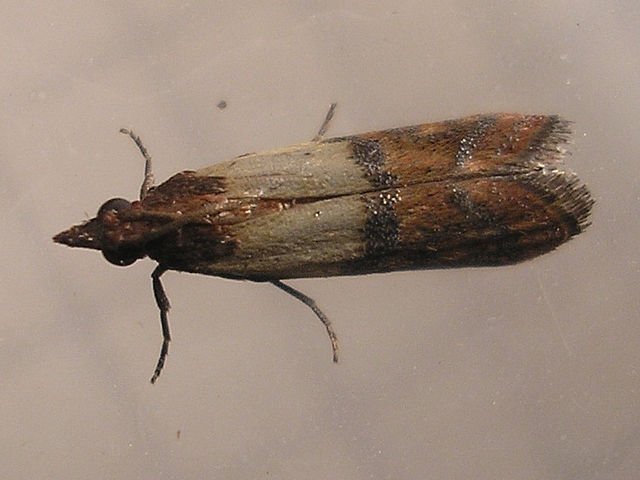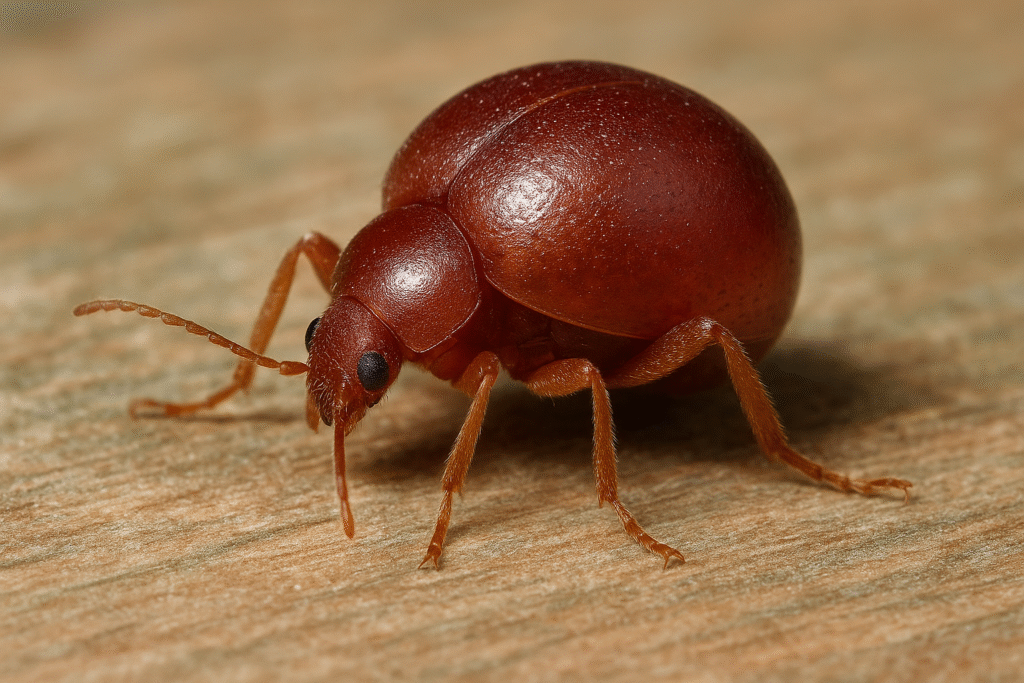Common Pantry Beetles (Stored Product Beetles): Identification and Control Guide
 Pantry beetles — also called stored product beetles — are among the most common pests found in kitchens, pantries, warehouses, and food-processing areas. Despite their small size, they can destroy large quantities of flour, cereals, pasta, dried herbs, pet food, and even tobacco or spices.
Pantry beetles — also called stored product beetles — are among the most common pests found in kitchens, pantries, warehouses, and food-processing areas. Despite their small size, they can destroy large quantities of flour, cereals, pasta, dried herbs, pet food, and even tobacco or spices.
I’ve treated hundreds of infestations where homeowners thought the problem was “a few bugs in the flour,” only to discover hundreds of larvae crawling inside food packages, behind shelves, and under appliances.
Unlike pantry moths (Plodia interpunctella) pantry beetles belong to several families of small Coleoptera (beetles) that specialize in dry stored foods. Understanding which species you’re dealing with is key to eliminating them for good.
Identification: What Do Pantry Beetles Look Like?
Most pantry beetles are tiny — between 2 and 5 mm long — with oval or cylindrical bodies, hard shells, and slow crawling movement. The color varies from reddish-brown to black, depending on the species.
Adults often hide inside packaging seams or fly toward light sources. The larvae (small, cream-colored worms) are the destructive stage, feeding on dried foods, grains, nuts, or spices.
Common signs include:
Small holes in packaging.
Fine powder or frass (insect dust) inside containers.
Adults crawling or flying near kitchen windows.
Major Pantry Beetle Species
Below are the main beetles that infest pantries and food-storage areas worldwide.
1. Drugstore Beetle (Stegobium paniceum)
The Drugstore Beetle, also known as the Bread Beetle, is a 2–3 mm reddish-brown beetle that feeds on almost anything organic — from pasta and cookies to books and leather.
Habitat: Pantries, libraries, museums.
Signs: Tiny round holes in packaging or objects.
Lifecycle: 4–6 weeks depending on temperature.
Control Tip: Remove all contaminated food, vacuum shelves, and apply residual insecticide into crevices.
This beetle is often confused with the Cigarette Beetle, but it has deeper grooves on its wing covers.
2. Cigarette Beetle (Lasioderma serricorne)
This small, light brown beetle prefers tobacco, spices, grains, and dried herbs. It’s a major pest in spice factories and herbal shops.
Key Trait: Smooth wing covers, unlike the Drugstore Beetle.
Behavior: Adults fly toward light; larvae feed inside dried materials.
Common Foods: Paprika, chili powder, flour, pasta, raisins, tobacco.
Professional Tip: Because larvae develop inside packaging, freezing infested items for 72 hours at -18°C is highly effective.
3. Red Flour Beetle (Tribolium castaneum)
A classic pantry pest found worldwide, especially in mills and bakeries.
Color: Reddish-brown, elongated body.
Feeding: Prefers broken grains, flour, bran, cereals.
Damage: Produces foul odor and mold growth.
Lifecycle: 4–5 weeks; several generations per year.
Note: They can live for up to a year under good conditions.
Closely related to the Confused Flour Beetle, but with slightly different antenna shape.
4. Confused Flour Beetle (Tribolium confusum)
Visually similar to the Red Flour Beetle, this species can’t fly. It thrives in temperate regions like Europe and North America.
Main Habitat: Pantries and warehouses.
Feeding: Attacks flour, nuts, dried fruit, spices.
Behavior: Slow-moving; larvae crawl near cracks and corners.
Control: Deep cleaning + pheromone traps for monitoring.
These two flour beetles are so similar that even professionals often need magnification to distinguish them.
5. Sawtoothed Grain Beetle (Oryzaephilus surinamensis)
Named for the saw-like projections on its thorax, this tiny beetle infests cereals, oats, rice, pasta, chocolate, and nuts.
Size: 2.5–3 mm.
Distinctive Trait: Flat body allowing entry into sealed packaging.
Lifecycle: 3–4 weeks; fast reproducer.
Prevention: Store dry foods in airtight containers; avoid bulk storage.
Closely related to the Merchant Grain Beetle, which prefers oil-rich foods.
6. Merchant Grain Beetle (Oryzaephilus mercator)
Nearly identical to the Sawtoothed Grain Beetle, but can fly. It’s common in warmer climates and food warehouses.
Diet: Nuts, chocolate, dried fruit, cereals.
Risk: Can contaminate processed food products.
Note: Adults can survive months without food.
Professional Insight: In large facilities, pheromone traps combined with sanitation programs are essential.
7. Larder Beetle (Dermestes lardarius)
Unlike most pantry beetles, the Larder Beetle prefers protein-rich materials like cured meats, pet food, cheese, and even dead insects or rodents.
Appearance: 7–9 mm long, dark brown with a pale yellow band across the wings.
Signs: Bore holes in wood or insulation near infested areas.
Hazard: Can damage taxidermy, wool, and leather.
Control: Remove animal residues, clean thoroughly, use residual insecticides.
Related to the Carpet Beetle, another household pest that damages fabrics.
8. Warehouse Beetle (Trogoderma variabile)
A serious pest in stored foods and grain facilities.
Appearance: Oval, brown with patterned hairs.
Feeding: Dry pet food, grains, cereals, nuts, cocoa, and spices.
Special Concern: Larvae are resistant to many insecticides.
Professional Tip: Heat treatments or fumigation are often required.
9. Khapra Beetle (Trogoderma granarium)
One of the world’s most dangerous stored-product pests and a regulated quarantine species in many countries.
Origin: South Asia, now spreading globally through trade.
Threat: Infests grain warehouses, shipping containers, and packaged goods.
Control: Extreme sanitation, temperature treatment, and strict import inspections.
Note: In the EU and USA, its detection triggers immediate quarantine and destruction of goods.
Global Distribution and Ecology
Pantry beetles occur worldwide — from tropical to temperate regions — following human food storage habits.
They thrive in warm, dark, and humid environments with easy food access. Infestations are most common in summer but can persist year-round in heated buildings.
Homes, restaurants, bakeries, and supermarkets are frequent targets, as well as long-term storage areas like warehouses and mills.
Risks and Damage
Pantry beetles don’t bite or harm humans, but they:
Contaminate food with larvae, frass, and shed skins.
Trigger allergic reactions in sensitive individuals.
Cause financial losses in food industries.
Spread mold through damaged packaging.
In severe infestations, entire batches of food products may be rejected or destroyed.
Signs of Infestation
Adult beetles crawling in or around food packages.
Fine dust or webbing inside bags or containers.
Small round holes in packaging or cardboard.
Off odors or discoloration in flour and cereals.
Larvae hiding in shelf cracks or corners.
Inspect all dried goods — even unopened packages — since larvae often chew through paper or plastic.
Control Methods (DIY & Professional)
1. Remove and Dispose
Throw away all infested food. Do not compost it. Seal and discard it outside.
2. Clean Thoroughly
Vacuum shelves, corners, and under appliances. Wash surfaces with warm soapy water or vinegar.
3. Seal Entry Points
Store food in glass or thick plastic containers. Avoid paper and cardboard.
4. Temperature Control
Freeze infested goods at -18°C for 3 days if possible, or heat-treat at 60°C for an hour. I know it is not possible in most cases.
5. Pheromone Traps
Use sticky traps to detect adult activity (useful for Red Flour Beetle and Sawtoothed Beetle). Not use a lot of that cause you will invite more.
6. Insecticides (Professional Use)
Use only approved residual insecticides in cracks, crevices, and structural voids — never spray directly on food or contact surfaces.
In large food facilities or warehouses, fumigation or controlled heat treatment may be required to eliminate deep infestations.
If the problem persists or the infestation is severe, contact a licensed pest control professional who can apply the right chemicals safely and according to your country’s regulations.
Advanced and Long-Term Prevention
Maintain dry, cool storage conditions (< 55% humidity).
Rotate stock (first in, first out).
Clean food-processing machines regularly.
Inspect raw materials before storage.
Schedule routine pest inspections — especially for commercial kitchens and warehouses.
Cultural and Historical Context
Humans have been battling pantry beetles since the very first grain storages in ancient Egypt and Mesopotamia. Archaeological studies have found traces of stored product insects inside 3,000-year-old tombs and granaries, showing that food pests have been part of human history since agriculture began.
These small creatures have caused major economic losses and foof shortages throughout history — sometimes even influencing trade routes and population movements. In several cases, widespread infestations led to famine and social disruption, reminding us how deeply food security depends on pest control.
Even today, global trade and food transport allow these beetles to travel easily inside flour, cocoa, dried fruit, and spices, making them one of the oldest and most persistent companions of civilization.
FAQ About Pantry Beetles
Q1: What attracts pantry beetles?
A: Dry foods like flour, rice, cereal, pet food, chocolate, and spices — especially when stored for long periods.
Q2: Are pantry beetles harmful to humans?
A: No direct harm, but they contaminate food and can cause allergies or asthma symptoms.
Q3: Can I use bleach to kill them?
A: Bleach kills surface bacteria but not larvae hidden in cracks. Use vacuuming and residual insecticide instead.
Q4: How long do pantry beetles live?
A: Adults live 2–6 months; complete life cycle takes 4–8 weeks.
Q5: Why do they keep coming back?
A: Hidden larvae or uncleaned food residues in cracks or old packaging.
Q6: Are pantry beetles the same as pantry moths?
A: No — pantry moths are flying insects (Lepidoptera), while beetles belong to Coleoptera and crawl rather than fly.
Final Thoughts
Pantry beetles are small, but the damage they cause can be big. Once they find a steady food source — a bag of flour, a box of pasta, or a forgotten jar of nuts — they multiply quickly and spread throughout your kitchen.
The key to success is patience and precision. Cleaning alone won’t help if larvae remain hidden in cracks or inside packaging. Combining deep sanitation, proper food storage, and targeted pest control treatments gives the best long-term results.
In my experience, most homeowners solve the problem only after identifying the exact species. What works against Red Flour Beetles may fail for Larder Beetles or Khapra Beetles. When infestations persist, it’s always worth calling a professional who can inspect and apply treatments safely, especially in commercial environments like bakeries or food warehouses.
Ultimately, prevention is the strongest tool: inspect all food before storage, maintain cleanliness, and avoid keeping open packages for long periods. Once you understand how these tiny invaders live and feed, keeping them out becomes much easier.
Learn more about other Stored Product Pests
Disclaimer
This article is for informational purposes only. Pest control laws and approved chemicals vary by country. For best results and legal safety, we strongly recommend contacting a licensed pest control professional in your local area. Always make sure that the pest control technician is properly certified or licensed, depending on your country’s regulations. It’s important to confirm that they only use approved products and apply them exactly as instructed on the product label. In most places in Europe, UK, or USA, following label directions is not just best practice—it’s the law.
Author
Nasos Iliopoulos
BSc Agronomist & Certified Pest Control Expert
Scientific Director – Advance Services (Athens, Greece)
Licensed Pest Control Business – Ministry of Rural Development & Food (GR)
References
NC STATE UNIVERISTY - Common Pantry Pests and their Management
National Pest Management Association (NPMA). (2024). Stored Product Beetles Identification & Control Manual.


